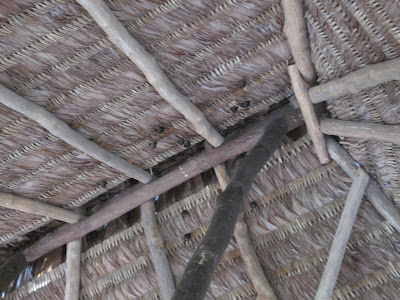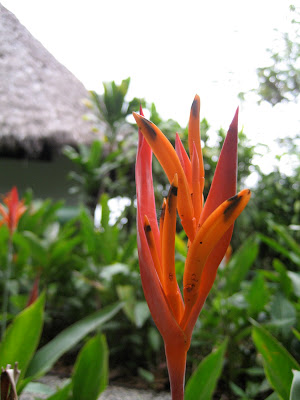After the lunch and the lizard-watching out on the main deck, we went up the really neat spiral staircase to the observatory deck.
The Brisa Azul restaurant...




Our observations: one large and lazy iguana, one tree-climbing iguana, several toucans, and bats! About 10 or so were roosting at the apex of the hut. They would occasionally stretch their wings and flit about.
Here's the Green Iguana - he didn't move for hours.

Chestnut-mandibled Toucan.


There's another iguana crawling up the tree, right in the center of the photo.

There he is again.

The bats...

On our way back to our #16 bungalow, also known as Tijerilla - which I have just looked up, and it is an earwig. Well that takes the mystique out of it! - we saw this mammal about the size of a raccoon all hurriedly go to this wall of rocks and dig out something like a madman then he proceeded to eat it, making great crackling sounds. It turns out it was a crab he was eating, a land crab. The animal, we later found out, was a White-Nosed Coati Mundi.

Examples of the tropical flora along the path back to the bungalow...







As I write now at 5:15 pm, I have the sounds of the waves, various birds, insects, howler monkeys all around me.
Also from our deck, we saw these birds that always seem to fly in pairs.




There were bats flitting around our deck at dusk. After hanging out there a while, we took showers and went to dinner.
We had the smoked tuna dip with chips for the appetizer. Yum! For our first course, Nick had the calamari and crab fritter; I had the feta cheese and macadamia nut salad with balsamic garlic dressing. Bats are flitting around the inside of the open-air restaurant. For the main course, Nick had blackened fish with cilantro rice, and I had the arroz con palmito. For dessert, we had the baby chocolate cake. All was delicious.
By now, of course, it's completely dark so you have to take flashlights with you to find the way back to your bungalow.
When we got to our room, there was a tarantula and a lizard about an inch or two from each other on our mesh window. The outside, thank God. It was a bit creepy but cool. We watched them for a while but nothing happened. They later disappeared.

Also, after I used the toilet, I noticed a giant, brown katydid on the back of the toilet lid! We gently removed the bug and placed it outside.

A gecko in our very neatly hand-crafted lamp...

While we were having dinner, the staff had come in and gotten the place ready for bed and placed a little laminated Buenas Noches card on our bed.

Off to sleep... I woke during the night from a deep sleep and had forgotten where I was. I thought it was dawn because I saw light, but then I realized that our outside light was left on, so I went back to sleep.
next post > day 11 - Lapa Rios Bungalow & Breakfast
previous post > day 10 - Lapa Rios!
first post > day 1 - Adventure, Exploration and Relaxation
The Brisa Azul restaurant...




Our observations: one large and lazy iguana, one tree-climbing iguana, several toucans, and bats! About 10 or so were roosting at the apex of the hut. They would occasionally stretch their wings and flit about.
Here's the Green Iguana - he didn't move for hours.

Chestnut-mandibled Toucan.


There's another iguana crawling up the tree, right in the center of the photo.

There he is again.

The bats...

On our way back to our #16 bungalow, also known as Tijerilla - which I have just looked up, and it is an earwig. Well that takes the mystique out of it! - we saw this mammal about the size of a raccoon all hurriedly go to this wall of rocks and dig out something like a madman then he proceeded to eat it, making great crackling sounds. It turns out it was a crab he was eating, a land crab. The animal, we later found out, was a White-Nosed Coati Mundi.

Examples of the tropical flora along the path back to the bungalow...







As I write now at 5:15 pm, I have the sounds of the waves, various birds, insects, howler monkeys all around me.
Also from our deck, we saw these birds that always seem to fly in pairs.




There were bats flitting around our deck at dusk. After hanging out there a while, we took showers and went to dinner.
We had the smoked tuna dip with chips for the appetizer. Yum! For our first course, Nick had the calamari and crab fritter; I had the feta cheese and macadamia nut salad with balsamic garlic dressing. Bats are flitting around the inside of the open-air restaurant. For the main course, Nick had blackened fish with cilantro rice, and I had the arroz con palmito. For dessert, we had the baby chocolate cake. All was delicious.
By now, of course, it's completely dark so you have to take flashlights with you to find the way back to your bungalow.
When we got to our room, there was a tarantula and a lizard about an inch or two from each other on our mesh window. The outside, thank God. It was a bit creepy but cool. We watched them for a while but nothing happened. They later disappeared.

Also, after I used the toilet, I noticed a giant, brown katydid on the back of the toilet lid! We gently removed the bug and placed it outside.

A gecko in our very neatly hand-crafted lamp...

While we were having dinner, the staff had come in and gotten the place ready for bed and placed a little laminated Buenas Noches card on our bed.

Off to sleep... I woke during the night from a deep sleep and had forgotten where I was. I thought it was dawn because I saw light, but then I realized that our outside light was left on, so I went back to sleep.
next post > day 11 - Lapa Rios Bungalow & Breakfast
previous post > day 10 - Lapa Rios!
first post > day 1 - Adventure, Exploration and Relaxation


Comments
Post a Comment